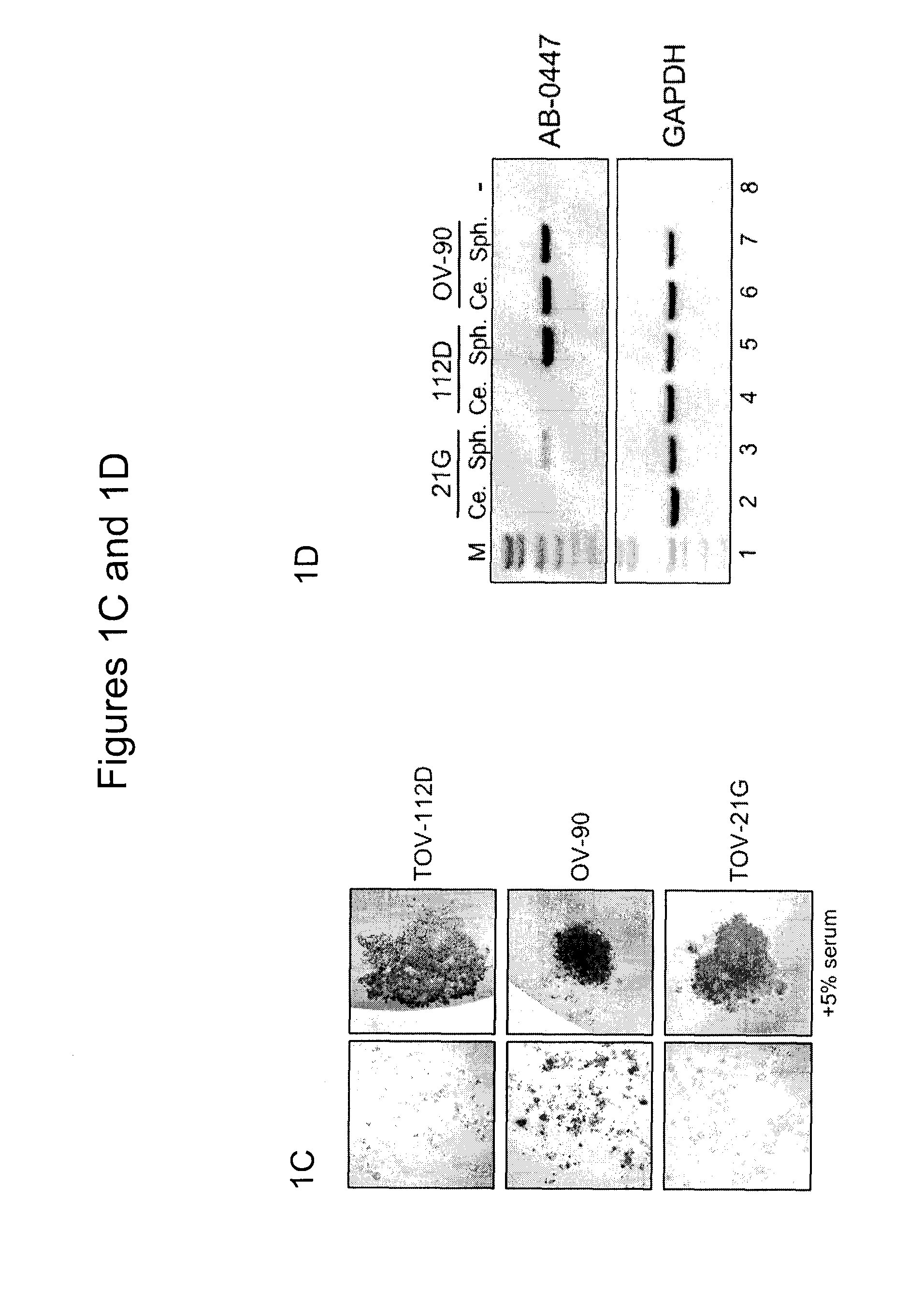Antibodies that specifically block the biological activity of a tumor antigen
a tumor antigen and antibody technology, applied in the field of monoclonal antibodies and antigen binding fragments, can solve the problems of high mortality rate, limited clinical application of test results for the detection of early stage disease, and high cost of strategy and not widely available, so as to achieve efficient mediation of adcc activity
- Summary
- Abstract
- Description
- Claims
- Application Information
AI Technical Summary
Benefits of technology
Problems solved by technology
Method used
Image
Examples
example 1
[0491]This example describes the pattern of expression of the KAAG1 gene in ovarian tumors and ovarian cancer cell line.
[0492]PCR analysis was performed to verify the percentage of ovarian tumors that express the mRNA encoding KAAG1 (indicated as AB-0447 in the Figure). The results showed that the KAAG1 gene is expressed in greater than 85% of ovarian tumors from all stages of the disease and 100% of late stage tumors. The expression of KAAG1 is lower or undetectable in LMP samples (see FIG. 1A). For each sample, 1 μg of amplified RNA was reverse transcribed with random hexamers using Thermoscript RT (Invitrogen). The cDNA was diluted and 1 / 200th of the reaction was used as template for each PCR reaction with gene-specific primers as indicated. The primers used to amplify the KAAG1 mRNA contained the sequences shown in SEQ ID NOS:45 and 46. PCR reactions were carried out in 96-well plates and half of the 25 μl reaction was electrophoresed on a 1% agarose gel. The gels were visualize...
example 2
[0498]This example describes in vitro results that suggest a critical role for KAAG1 in the survival of ovarian cancer cells.
[0499]With the demonstration that KAAG1 expression is regulated in ovarian cancer cells, the function of this gene in these cells was examined. To address this question, in vitro assays were conducted to determine if this protein plays a role in cancer cell proliferation, migration, and / or survival. RNAi was used to knock down the expression of the endogenous KAAG1 gene in the TOV-21G ovarian cancer cell line. The design of two separate short-hairpin RNA (shRNA) sequences was performed using web-based software that is freely available to those skilled in the art (Qiagen for example). These chosen sequences, usually 19-mers, were included in two complementary oligonucleotides that form the template for the shRNAs, i.e. the 19-nt sense sequence, a 9-nt linker region (loop), the 19-nt antisense sequence followed by a 5-6 poly-T tract for termination of the RNA po...
example 3
[0503]This example provides details pertaining to the family of monoclonal antibodies that bind to KAAG1.
[0504]The antibodies that bind KAAG1 were generated using the Biosite phage display technology. A detailed description of the technology and the methods for generating these antibodies can be found in the U.S. Pat. No. 6,057,098. Briefly, the technology utilizes stringent panning of phage libraries that display the antigen binding fragments (Fabs). After a several rounds of panning, a library, termed the Omniclonal, was obtained that was enriched for recombinant Fabs containing light and heavy chain variable regions that bound to KAAG1 with very high affinity and specificity. From this library, more precisely designated Omniclonal AL0003Z1, 96 individual recombinant monoclonal Fabs were prepared from E. coli and tested for KAAG1 binding.
[0505]To measure the relative binding of each individual monoclonal antibody, recombinant human KAAG1 was produced in 293E cells using the large-...
PUM
| Property | Measurement | Unit |
|---|---|---|
| Fraction | aaaaa | aaaaa |
| Fraction | aaaaa | aaaaa |
| Volume | aaaaa | aaaaa |
Abstract
Description
Claims
Application Information
 Login to View More
Login to View More - R&D
- Intellectual Property
- Life Sciences
- Materials
- Tech Scout
- Unparalleled Data Quality
- Higher Quality Content
- 60% Fewer Hallucinations
Browse by: Latest US Patents, China's latest patents, Technical Efficacy Thesaurus, Application Domain, Technology Topic, Popular Technical Reports.
© 2025 PatSnap. All rights reserved.Legal|Privacy policy|Modern Slavery Act Transparency Statement|Sitemap|About US| Contact US: help@patsnap.com



